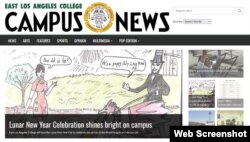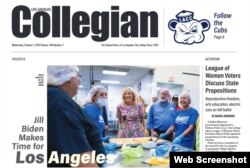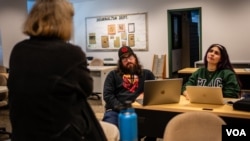For years, Marc Anthony Martinez worked delivery jobs in Los Angeles and across the U.S.
One of his regular stops: the University of Southern California village. Martinez, 33, says he would drop off food deliveries and wonder what it would be like to go to school there.
“After a while I was like, ‘You know what? I write pretty good, I love traveling, why don’t I try to go into journalism and try to become a sports journalist?’” he said.
So in April 2022, Martinez enrolled in the journalism program at East Los Angeles College.
Nearly two years on, Martinez is editor in chief for the community college newspaper, Campus News.
Founded in 1945, Campus News has won several awards, including from the Journalism Association of Community Colleges SoCal conference.
But before students can publish work in Campus News, they must take the college’s Journalism 101 class.
Jean Stapleton, chairperson of the college journalism department and adviser for Campus News, provides that training.
First comes a writing test, then classes on subjects such as how to write news articles and on media ethics.
The emphasis, Martinez said, is on the responsibilities reporters will have in their careers.
Entering his second semester at the newspaper, Martinez said that the newspaper’s flexibility allows him to do his “own thing,” whether that is drafting sports stories or exploring photojournalism.
A self-proclaimed introvert, Martinez says joining the newspaper also provided opportunities to push himself outside of his comfort zone.
“That’s what I tell the other journalists, ‘Look I know its nerve wracking but it’s also part of the thrill of journalism.’ You’re pushing yourself and expanding your limits on how far you can go,” he said.
Journalism 101
In downtown Los Angeles, the Los Angeles City College newspaper team takes a similar approach.
Sorina Szakacs, who is active with LACC’s The Collegian, says the newspaper offers classes to improve students’ reporting skills.
Szakacs, who is now studying at Columbia University in New York, graduated from LACC in 2019.
She still contributes to The Collegian as a reporter and editor, and sometimes audits the college’s journalism classes.
The classes, she said, are demanding but help students know if they are interested in pursuing a career in journalism.
“Once you’re working in the newspaper, you know what is expected of you. By the time you finish, you know if journalism is the career for you or not,” Szakacs said.
Students don’t just work on reporting and editing. They also help with distribution, loading trucks with print copies that are delivered to homes and businesses.
Szakacs recalls being on a distribution run and seeing people emerge from their houses as soon as copies are dropped off.
Residents also will often write emails and letters or call with tips and questions, which she says shows an interest in the newspaper as a part of the community.
“There is a need for it. People are waiting for it,” she said. “That’s why we write — for them.”
While The Collegian is part of the largest community college district in the nation and covers a more extensive area, Campus News focuses on more specific issues surrounding student issues and life on campus.
Martinez says he is interested in features about people on campus who might otherwise be overlooked.
“We got to find people that we don’t necessarily know that are on our campus,” he said.
He recalls approaching a student after seeing their drawings and asking if they would be open to an interview.
More recently, a student pitched a story on a group that sets up and breaks down equipment for sports games.
“That’s what makes our paper good. It shows recognition to those that need it and deserve it,” Martinez said.
He finds that features display an appreciation toward community members and help increase the visibility of Campus News. After a student or teacher is featured in the paper, they often ask for copies of the newspaper, he said.
“They’ll take a couple of copies for themselves and give it to their families, and they’ll have it. That’s what keeps our paper going,” he said.
But the student reporters sometimes run into challenges.
In May, the music department at LACC prohibited a photojournalist from covering an event for the outgoing president, telling them it was a private event.
Music department officials later said there had been a “miscommunication.”
Later that month, the sheriff’s deputies who do campus security confronted another student who was taking photos in common areas around the music building.
Coverage of the incidents reached the Los Angeles Times and the Student Press Law Center. Students also reported on it in The Collegian.
Next generation
Both community colleges offer a strong foundation in media skills, but the students are wary of the job market.
So far this year, the newspaper industry has seen a massive layoff at the Los Angeles Times in January and at other U.S. newsrooms.
Martinez and Szakacs say that because many community college students transfer to four-year universities, those who are committed to a career in journalism will find ways to adapt.
For Szakacs, the situation made her hesitant to return to Los Angeles.
Martinez says he isn’t as concerned for sports journalism or photojournalism, but that his plans may change.
Szakacs said that as times change, so, too, should the industry.
Embracing technological advancements may help provide solutions for journalism, she said.
Student journalists can be a part of that, she said. They can help fill the gap of stories that major newspapers lack resources or interest in reporting on.
“It’s not easy,” Szakacs said. “It’s never going to be easy, but that’s what it means to be a journalist.”



